battery MITSUBISHI OUTLANDER PHEV 2016 (in English) User Guide
[x] Cancel search | Manufacturer: MITSUBISHI, Model Year: 2016, Model line: OUTLANDER PHEV, Model: MITSUBISHI OUTLANDER PHEV 2016Pages: 490, PDF Size: 22.02 MB
Page 24 of 490
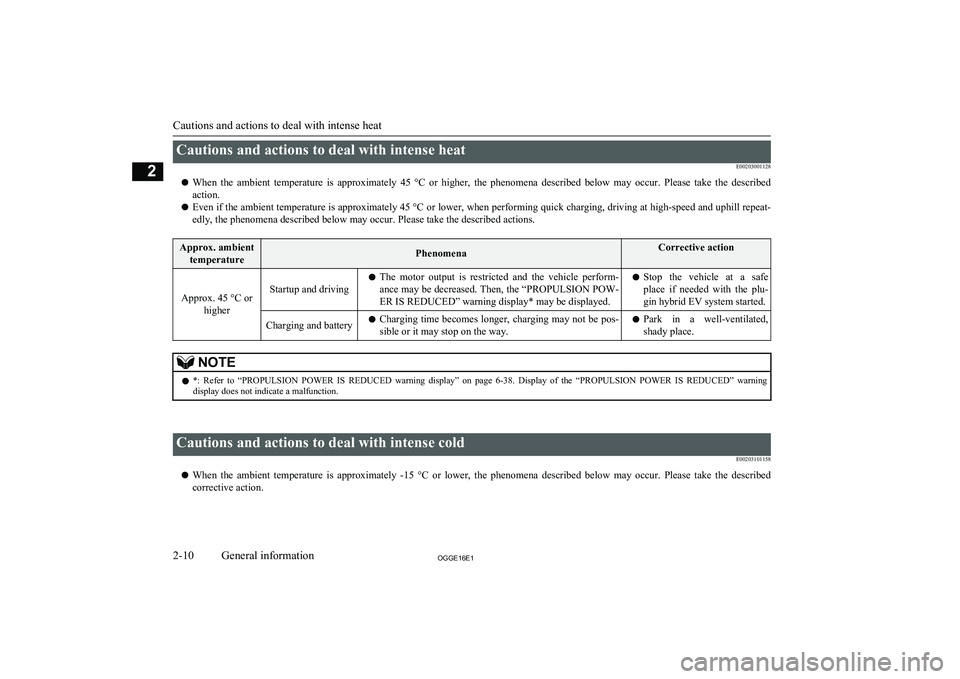
Cautions and actions to deal with intense heatE00203001128
l When the ambient temperature is approximately 45 °C or higher, the phenomena described below may occur. Please take the described
action.
l Even if the ambient temperature is approximately
45 °C or lower, when performing quick charging, driving at high-speed and uphill repeat-
edly, the phenomena described below may occur. Please take the described actions.Approx. ambient temperaturePhenomenaCorrective action
Approx. 45 °C or higherStartup and drivinglThe motor output is restricted and the vehicle perform-
ance may be decreased. Then, the “PROPULSION POW-
ER IS REDUCED” warning display* may be displayed.l Stop the vehicle at a safe
place if needed with the plu- gin hybrid EV system started.Charging and batteryl Charging time becomes longer, charging may not be pos-
sible or it may stop on the way.l Park in a well-ventilated,
shady place.NOTEl *: Refer to “PROPULSION POWER IS REDUCED warning display” on page
6-38. Display of the “PROPULSION POWER IS REDUCED” warning
display does not indicate a malfunction.
Cautions and actions to deal with intense cold
E00203101158
l When the ambient temperature is approximately -15 °C or lower, the phenomena described below may occur. Please take the described
corrective action.
Cautions and actions to deal with intense heat
2-10OGGE16E1General information2
Page 25 of 490
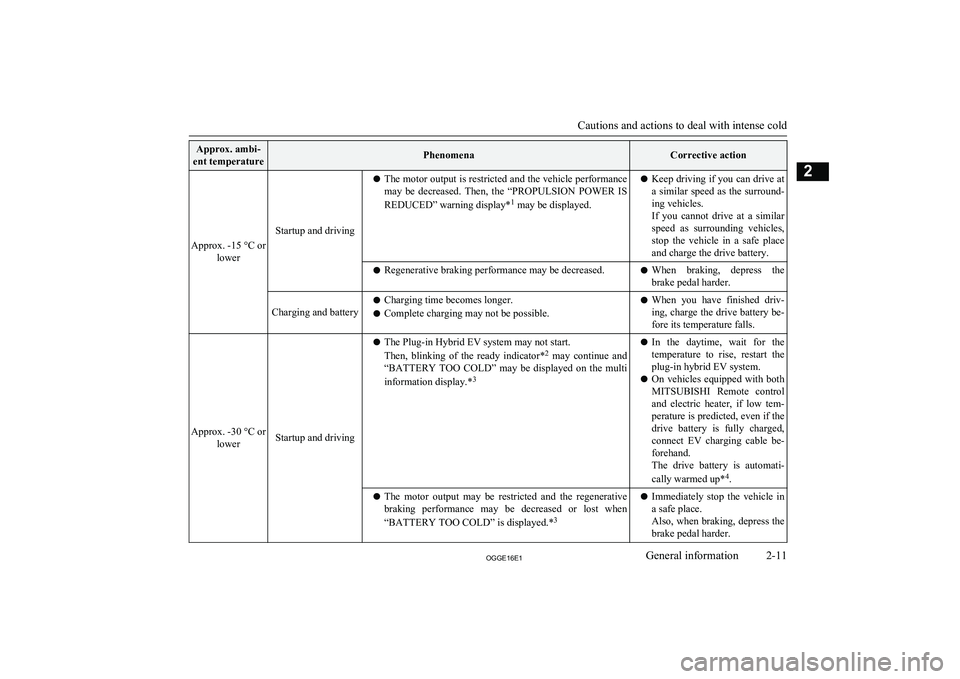
Approx. ambi-
ent temperaturePhenomenaCorrective action
Approx. -15 °C or lower
Startup and driving
lThe motor output is restricted and the vehicle performance
may be decreased. Then, the “PROPULSION POWER IS
REDUCED” warning display* 1
may be displayed.l Keep driving if you can drive at
a similar speed as the surround-
ing vehicles.
If you cannot drive at a similar
speed as surrounding vehicles, stop the vehicle in a safe placeand charge the drive battery.l Regenerative braking performance may be decreased.lWhen braking, depress the
brake pedal harder.Charging and batteryl Charging time becomes longer.
l Complete charging may not be possible.lWhen you have finished driv-
ing, charge the drive battery be- fore its temperature falls.
Approx. -30 °C or lowerStartup and driving
lThe Plug-in Hybrid EV system may not start.
Then, blinking of the ready indicator* 2
may continue and
“BATTERY TOO COLD” may be displayed on the multi
information display.* 3l
In the daytime, wait for the
temperature to rise, restart the plug-in hybrid EV system.
l On vehicles equipped with both
MITSUBISHI Remote control
and electric heater, if low tem-
perature is predicted, even if the drive battery is fully charged, connect EV charging cable be-
forehand.
The drive battery is automati-
cally warmed up* 4
.l The motor output may be restricted and the regenerative
braking performance may be decreased or lost when
“BATTERY TOO COLD” is displayed.* 3l
Immediately stop the vehicle in
a safe place.
Also, when braking, depress the
brake pedal harder.
Cautions and actions to deal with intense cold
2-11OGGE16E1General information2
Page 26 of 490
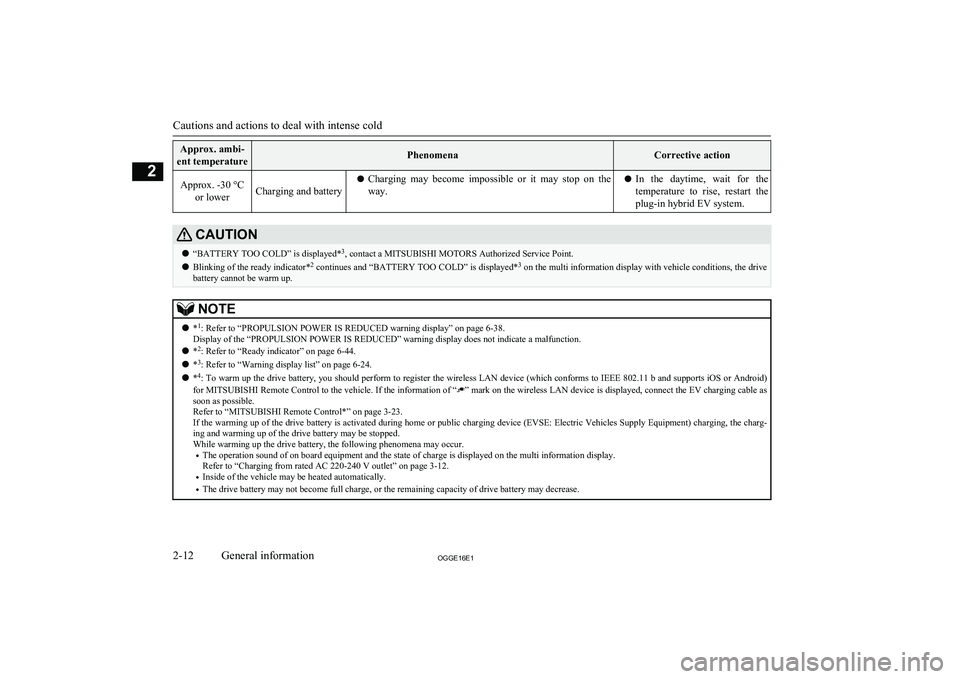
Approx. ambi-
ent temperaturePhenomenaCorrective actionApprox. -30 °C or lowerCharging and batterylCharging may become impossible or it may stop on the
way.l In the daytime, wait for the
temperature to rise, restart theplug-in hybrid EV system.CAUTIONl “BATTERY TOO COLD” is displayed* 3
, contact a MITSUBISHI MOTORS Authorized Service Point.
l Blinking of the ready indicator* 2
continues and “BATTERY TOO COLD” is displayed* 3
on the multi information display with vehicle conditions, the drive
battery cannot be warm up.NOTEl *1
: Refer to “PROPULSION POWER IS REDUCED warning display” on page 6-38.
Display of the “PROPULSION POWER IS REDUCED” warning display does not indicate a malfunction.
l *2
: Refer to “Ready indicator” on page 6-44.
l *3
: Refer to “Warning display list” on page 6-24.
l *4
: To warm up the drive battery, you should perform to register the wireless LAN device (which conforms to IEEE 802.11 b and supports iOS or Android)
for MITSUBISHI Remote Control to the vehicle. If the information of “
” mark on the wireless LAN device is displayed, connect the EV charging cable as
soon as possible.
Refer to “MITSUBISHI Remote Control*” on page 3-23.
If the warming up of the drive battery is activated during home or public charging device (EVSE: Electric Vehicles Supply Equipment) charging, the charg-
ing and warming up of the drive battery may be stopped.
While warming up the drive battery, the following phenomena may occur.
• The operation sound of on board equipment and the state of charge is displayed on the multi information display.
Refer to “Charging from rated AC 220-240 V outlet” on page 3-12.
• Inside of the vehicle may be heated automatically.
• The drive battery may not become full charge, or the remaining capacity of drive battery may decrease.
Cautions and actions to deal with intense cold
2-12OGGE16E1General information2
Page 28 of 490
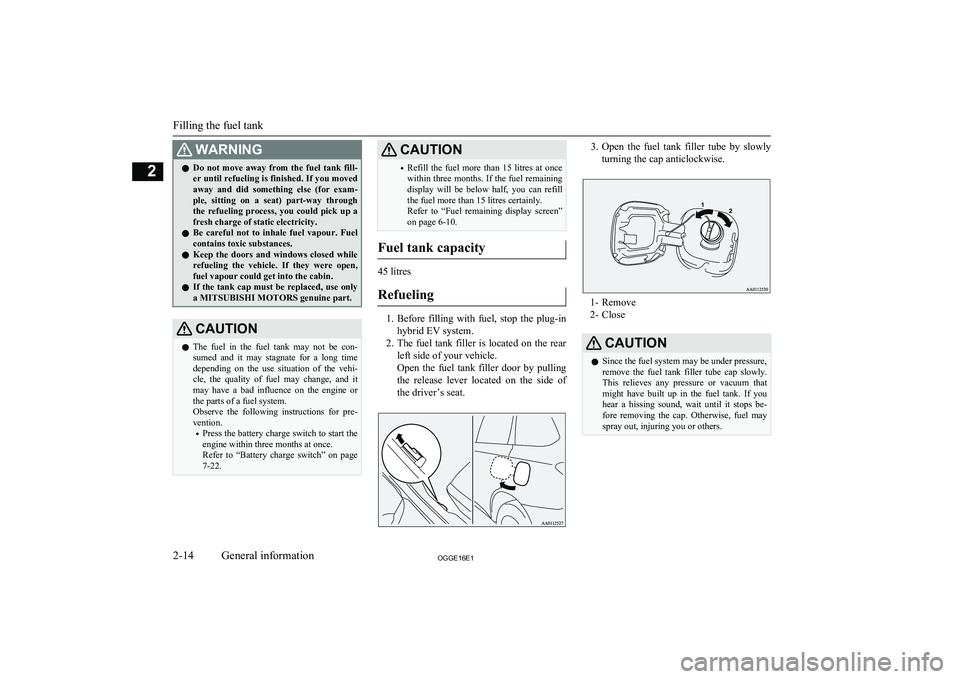
WARNINGlDo not move away from the fuel tank fill-
er until refueling is finished. If you moved away and did something else (for exam-
ple, sitting on a seat) part-way through the refueling process, you could pick up afresh charge of static electricity.
l Be careful not to inhale fuel vapour. Fuel
contains toxic substances.
l Keep the doors and windows closed while
refueling the vehicle. If they were open,fuel vapour could get into the cabin.
l If the tank cap must be replaced, use only
a MITSUBISHI MOTORS genuine part.CAUTIONl The fuel in the fuel tank may not be con-
sumed and it may stagnate for a long time
depending on the use situation of the vehi- cle, the quality of fuel may change, and it
may have a bad influence on the engine or the parts of a fuel system.
Observe the following instructions for pre-
vention.
• Press the battery charge switch to start the
engine within three months at once.Refer to “Battery charge switch” on page
7-22.CAUTION• Refill the fuel more than 15 litres at once
within three months. If the fuel remaining display will be below half, you can refill
the fuel more than 15 litres certainly. Refer to “Fuel remaining display screen” on page 6-10.
Fuel tank capacity
45 litres
Refueling
1. Before filling with fuel, stop the plug-in
hybrid EV system.
2. The fuel tank filler is located on the rear
left side of your vehicle.
Open the fuel tank filler door by pulling the release lever located on the side of the driver’s seat.
3. Open the fuel tank filler tube by slowly
turning the cap anticlockwise.
1- Remove
2- Close
CAUTIONl Since the fuel system may be under pressure,
remove the fuel tank filler tube cap slowly. This relieves any pressure or vacuum that
might have built up in the fuel tank. If you
hear a hissing sound, wait until it stops be- fore removing the cap. Otherwise, fuel may
spray out, injuring you or others.
Filling the fuel tank
2-14OGGE16E1General information2
Page 33 of 490
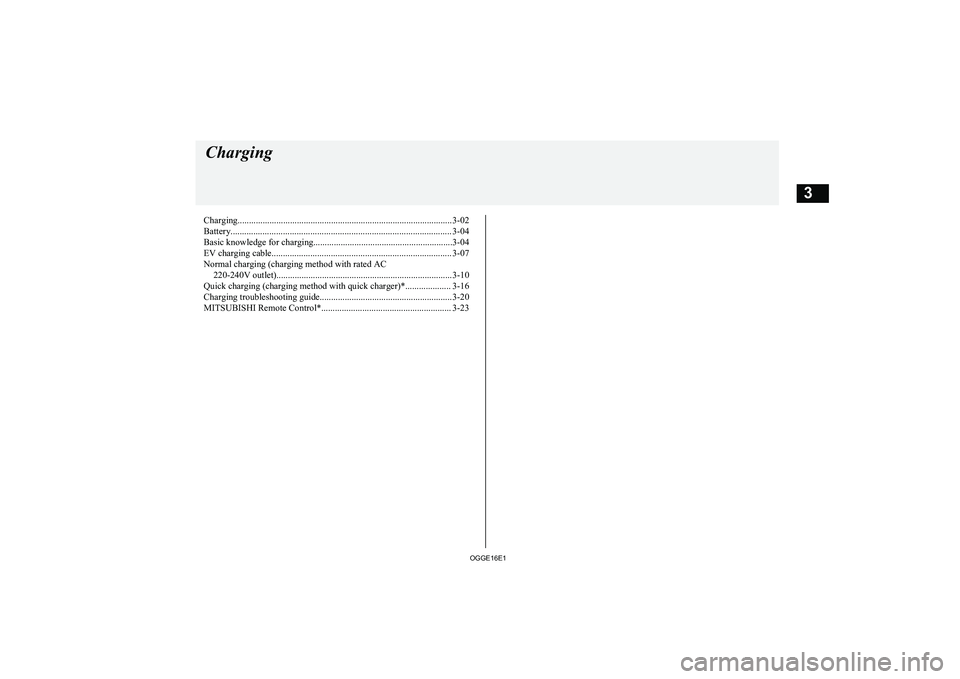
Charging.............................................................................................. 3-02
Battery................................................................................................. 3-04 Basic knowledge for charging.............................................................3-04
EV charging cable............................................................................... 3-07
Normal charging (charging method with rated AC 220-240V outlet).............................................................................3-10
Quick charging (charging method with quick charger)*.................... 3-16
Charging troubleshooting guide.......................................................... 3-20 MITSUBISHI Remote Control*......................................................... 3-23Charging
OGGE16E13
Page 34 of 490
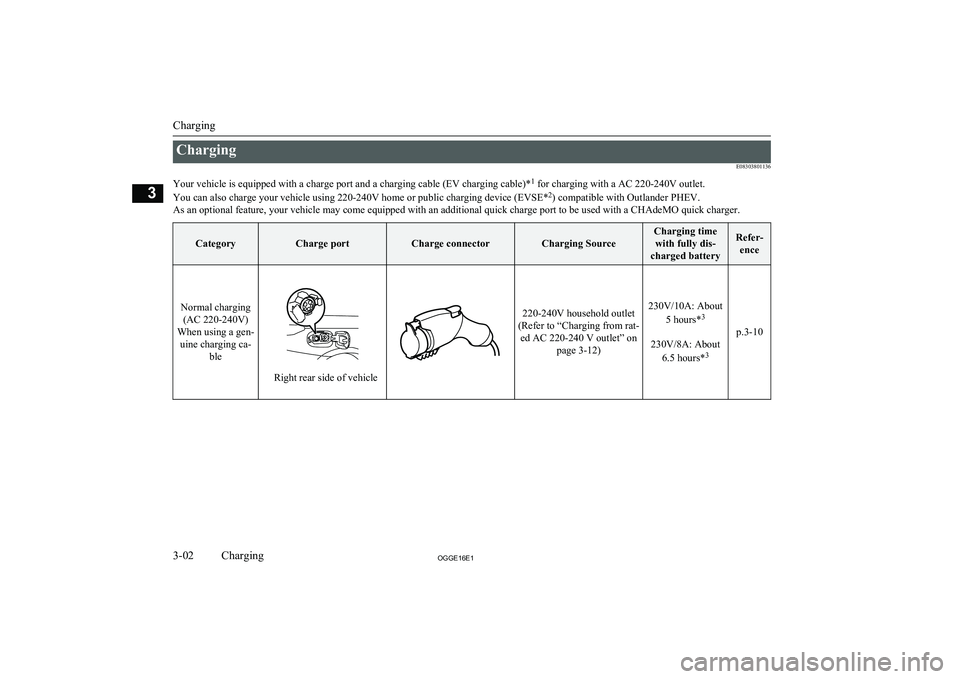
ChargingE08303801136
Your vehicle is equipped with a charge port and a charging cable (EV charging cable)* 1
for charging with a AC 220-240V outlet.
You can also charge your vehicle using 220-240V home or public charging device (EVSE* 2
) compatible with Outlander PHEV.
As an optional feature, your vehicle may come equipped with an additional quick charge port to be used with a CHAdeMO quick charger.CategoryCharge portCharge connectorCharging Source
Charging time with fully dis-
charged batteryRefer- ence
Normal charging(AC 220-240V)
When using a gen- uine charging ca- ble
Right rear side of vehicle
220-240V household outlet
(Refer to “Charging from rat- ed AC 220-240 V outlet” on page 3-12)230V/10A: About
5 hours* 3
230V/8A: About
6.5 hours* 3
p.3-10
Charging
3-02OGGE16E1Charging3
Page 35 of 490
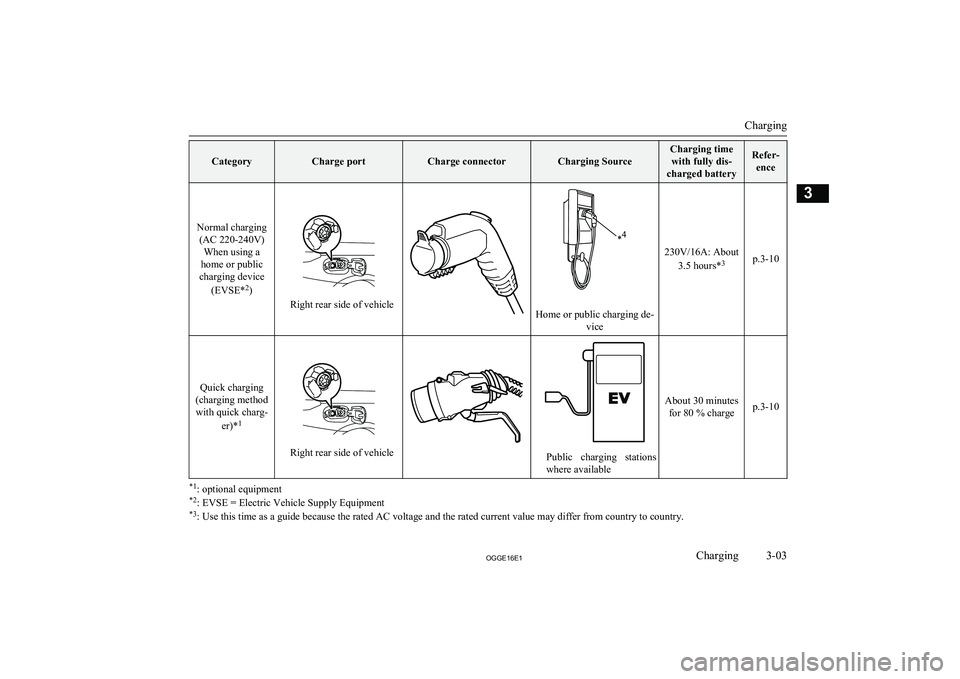
CategoryCharge portCharge connectorCharging Source
Charging timewith fully dis-
charged batteryRefer- ence
Normal charging(AC 220-240V) When using a
home or public
charging device
(EVSE* 2
)
Right rear side of vehicleHome or public charging de-
vice
230V/16A: About
3.5 hours* 3p.3-10
Quick charging
(charging method with quick charg-
er)*1
Right rear side of vehiclePublic charging stations
where available
About 30 minutes for 80 % chargep.3-10
*1 : optional equipment
*2 : EVSE = Electric Vehicle Supply Equipment
*3 : Use this time as a guide because the rated AC voltage and the rated current value may differ from country to country.
Charging
3-03OGGE16E1Charging3
Page 36 of 490
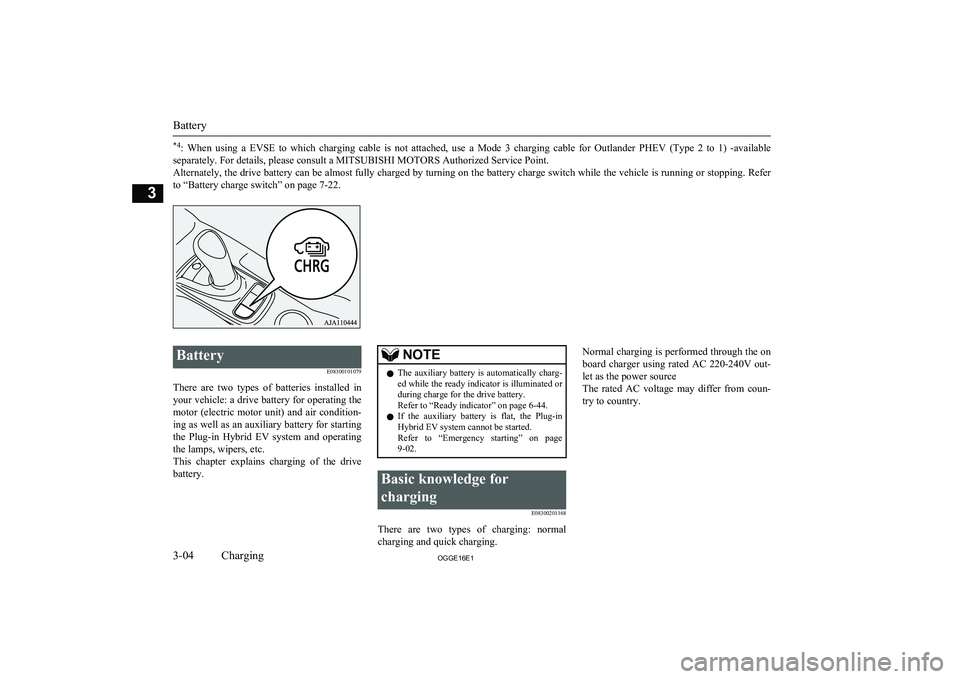
*4: When using a EVSE to which charging cable is not attached, use a Mode 3 charging cable for Outlander PHEV (Type 2 to 1) -available
separately. For details, please consult a MITSUBISHI MOTORS Authorized Service Point.
Alternately, the drive battery can be almost fully charged by turning on the battery charge switch while the vehicle is running or stopping. Refer to “Battery charge switch” on page 7-22.
Battery
E08300101079
There are two types of batteries installed in your vehicle: a drive battery for operating the
motor (electric motor unit) and air condition-
ing as well as an auxiliary battery for starting the Plug-in Hybrid EV system and operatingthe lamps, wipers, etc.
This chapter explains charging of the drive battery.NOTEl The auxiliary battery is automatically charg-
ed while the ready indicator is illuminated orduring charge for the drive battery.
Refer to “Ready indicator” on page 6-44.
l If the auxiliary battery is flat, the Plug-in
Hybrid EV system cannot be started.Refer to “Emergency starting” on page
9-02.Basic knowledge for
charging E08300201168
There are two types of charging: normalcharging and quick charging.
Normal charging is performed through the on
board charger using rated AC 220-240V out-
let as the power source
The rated AC voltage may differ from coun-
try to country.
Battery
3-04OGGE16E1Charging3
Page 37 of 490
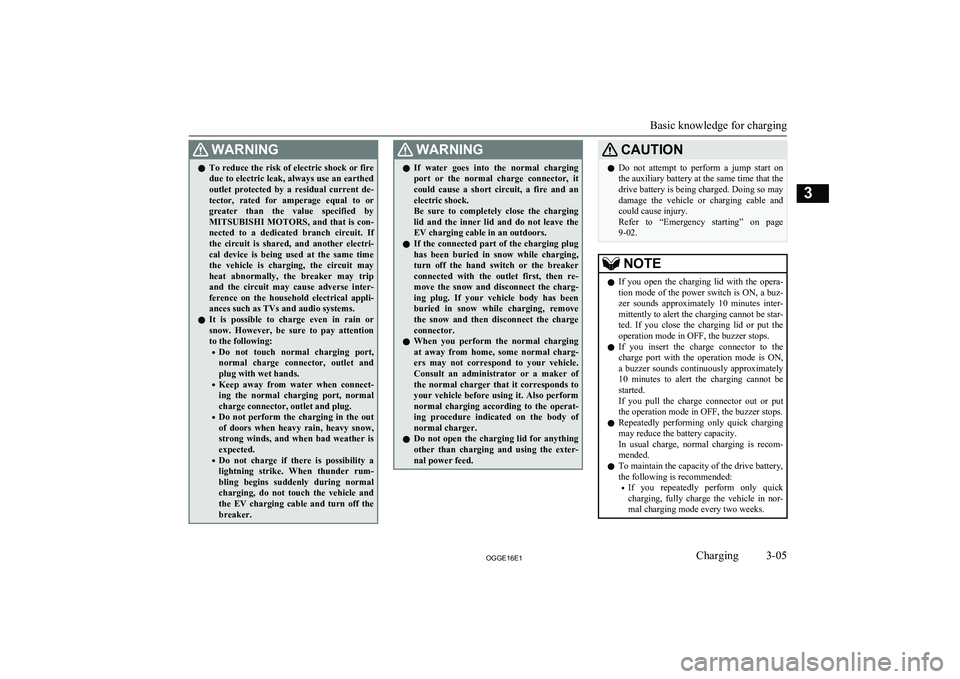
WARNINGlTo reduce the risk of electric shock or fire
due to electric leak, always use an earthed
outlet protected by a residual current de-
tector, rated for amperage equal to or greater than the value specified by MITSUBISHI MOTORS , and that is con-
nected to a dedicated branch circuit. If
the circuit is shared, and another electri- cal device is being used at the same time
the vehicle is charging, the circuit may heat abnormally, the breaker may trip
and the circuit may cause adverse inter-
ference on the household electrical appli- ances such as TVs and audio systems.
l It is possible to charge even in rain or
snow. However, be sure to pay attention
to the following:
• Do not touch normal charging port,
normal charge connector, outlet and plug with wet hands.
• Keep away from water when connect-
ing the normal charging port, normal
charge connector, outlet and plug.
• Do not perform the charging in the out
of doors when heavy rain, heavy snow, strong winds, and when bad weather is
expected.
• Do not charge if there is possibility a
lightning strike. When thunder rum- bling begins suddenly during normal
charging, do not touch the vehicle and the EV charging cable and turn off the
breaker.WARNINGl If water goes into the normal charging
port or the normal charge connector, itcould cause a short circuit, a fire and an electric shock.
Be sure to completely close the charging lid and the inner lid and do not leave the
EV charging cable in an outdoors.
l If the connected part of the charging plug
has been buried in snow while charging,
turn off the hand switch or the breaker
connected with the outlet first, then re- move the snow and disconnect the charg-
ing plug. If your vehicle body has been buried in snow while charging, remove
the snow and then disconnect the charge connector.
l When you perform the normal charging
at away from home, some normal charg-ers may not correspond to your vehicle.
Consult an administrator or a maker of
the normal charger that it corresponds to your vehicle before using it. Also perform
normal charging according to the operat-
ing procedure indicated on the body of normal charger.
l Do not open the charging lid for anything
other than charging and using the exter-
nal power feed.CAUTIONl Do not attempt to perform a jump start on
the auxiliary battery at the same time that the
drive battery is being charged. Doing so may
damage the vehicle or charging cable and
could cause injury.
Refer to “Emergency starting” on page 9-02.NOTEl If you open the charging lid with the opera-
tion mode of the power switch is ON, a buz- zer sounds approximately 10 minutes inter-mittently to alert the charging cannot be star- ted. If you close the charging lid or put theoperation mode in OFF, the buzzer stops.
l If you insert the charge connector to the
charge port with the operation mode is ON,
a buzzer sounds continuously approximately
10 minutes to alert the charging cannot be started.
If you pull the charge connector out or put the operation mode in OFF, the buzzer stops.
l Repeatedly performing only quick charging
may reduce the battery capacity.
In usual charge, normal charging is recom-
mended.
l To maintain the capacity of the drive battery,
the following is recommended:
• If you repeatedly perform only quick
charging, fully charge the vehicle in nor-
mal charging mode every two weeks.
Basic knowledge for charging
3-05OGGE16E1Charging3
Page 38 of 490
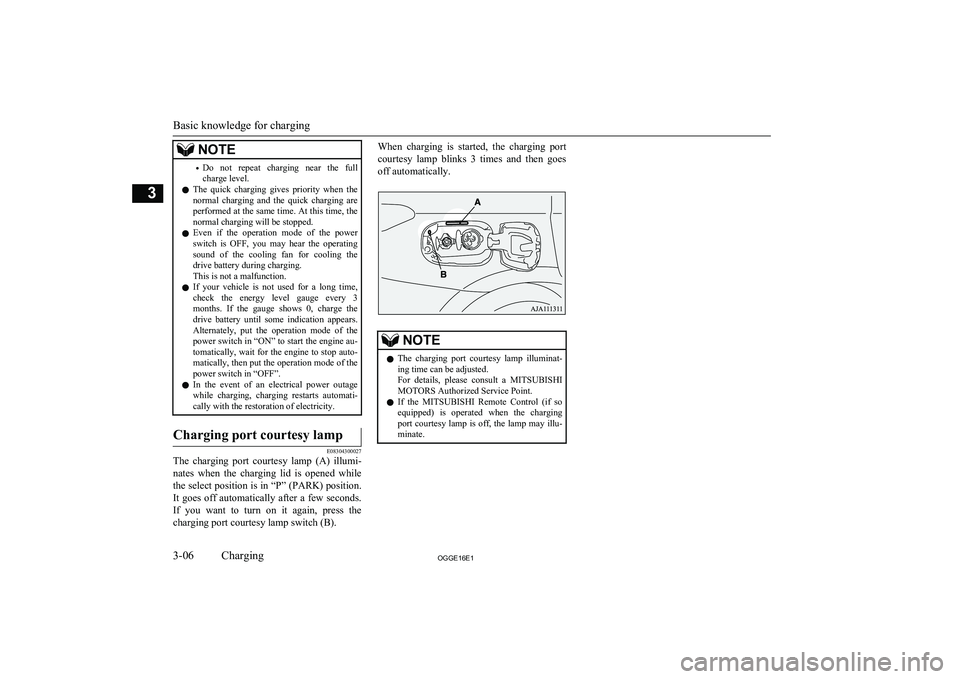
NOTE•Do not repeat charging near the full
charge level.
l The quick charging gives priority when the
normal charging and the quick charging are performed at the same time. At this time, thenormal charging will be stopped.
l Even if the operation mode of the power
switch is OFF, you may hear the operating sound of the cooling fan for cooling the
drive battery during charging.
This is not a malfunction.
l If your vehicle is not used for a long time,
check the energy level gauge every 3 months. If the gauge shows 0, charge thedrive battery until some indication appears.
Alternately, put the operation mode of the
power switch in “ON” to start the engine au- tomatically, wait for the engine to stop auto-matically, then put the operation mode of the
power switch in “OFF”.
l In the event of an electrical power outage
while charging, charging restarts automati- cally with the restoration of electricity.Charging port courtesy lamp
E08304300027
The charging port courtesy lamp (A) illumi-
nates when the charging lid is opened while
the select position is in “P” (PARK) position. It goes off automatically after a few seconds.If you want to turn on it again, press the charging port courtesy lamp switch (B).
When charging is started, the charging port
courtesy lamp blinks 3 times and then goes off automatically.NOTEl The charging port courtesy lamp illuminat-
ing time can be adjusted.
For details, please consult a MITSUBISHI
MOTORS Authorized Service Point.
l If the
MITSUBISHI Remote Control (if so
equipped) is operated when the charging
port courtesy lamp is off, the lamp may illu-
minate.
Basic knowledge for charging
3-06OGGE16E1Charging3